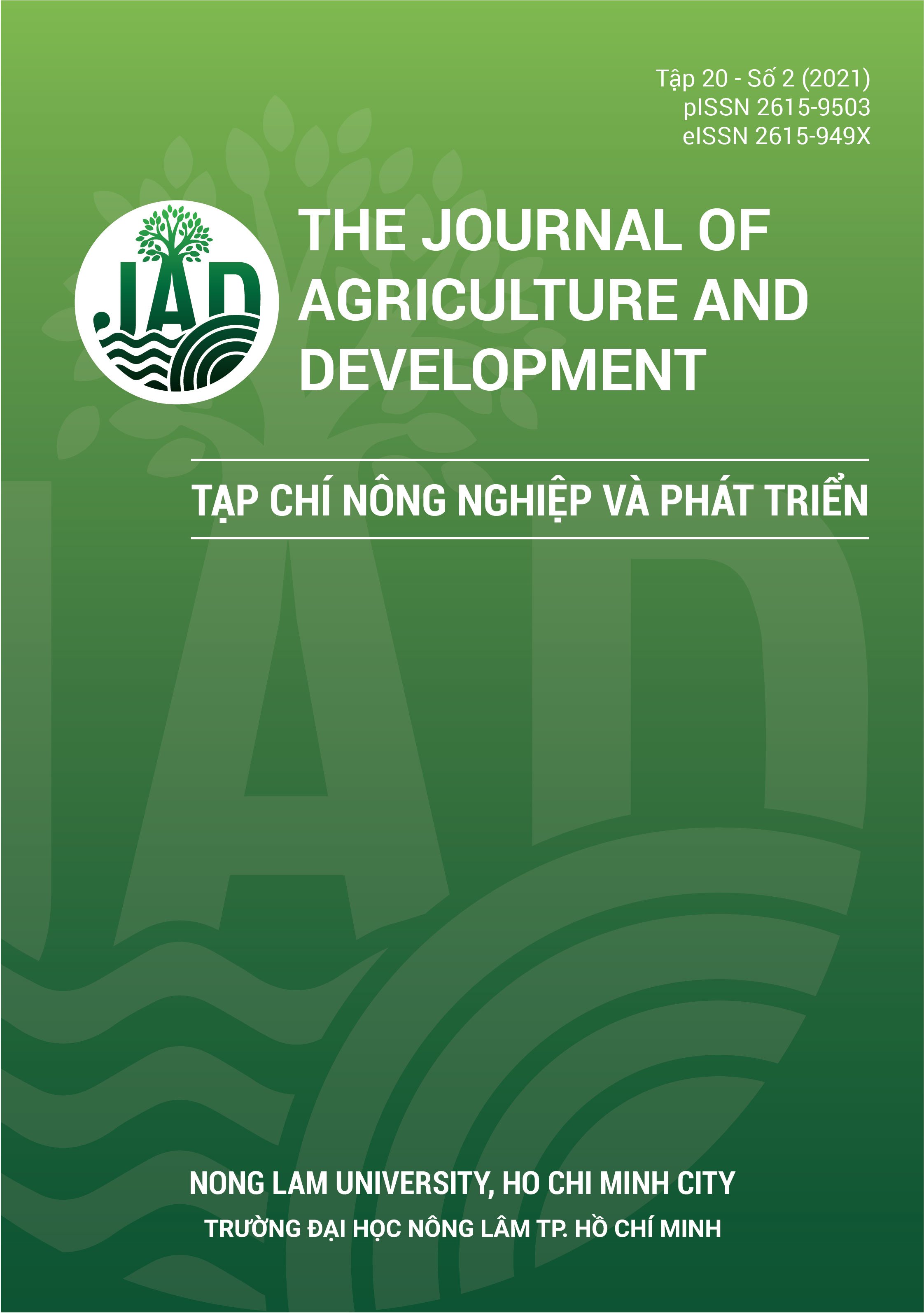The distribution and presence of versicular-arbuscular mycorrhiza fungi in rhizosphere soil of Da Xanh pummelo in Ba Ria Vung Tau province
Main Article Content
Abstract
The study was carried out to determine the distribution and pres-ence of versicular-arbuscular mycorrhiza (VAM) fungi in rhizo-sphere soil and roots of Da Xanh pummelo in Phu My town, Ba Ria Vung Tau province. The rhizosphere soil and root samples
were collected from 6 - 7 years old pummelo of two main soil types, on two soil layers at depths of 0 - 20 cm and 20 - 40 cm, at
2/3 and the edge of canopy. The results showed that the presence of VAM spore density was higher in red basaltic soil (ferralsols) than black soil (luvisols), and common exist on the topsoil layer (0 - 20 cm) as well as the edge of canopy. Glomus and Acaulospora were two most abundant genera in survey areas, and the propor-tion of mycorrhizal spores ranged from 53.18 ± 2.59% to 58.54 ± 0.46 and from 23.68 ± 2.96% to 29.33 ± 0.64%, respectively. Increasing the soil depth negatively affected on spore density of VAM fungi. The VAM fungi composition aslo changed with soil depth. The percentage of root colonization by VAM fungi ranged from 56.20 ± 3.11% to 62.00 ± 3.37%, and the highest percentage of root colonization by VAM fungi was detected in red basaltic soil.
Article Details
References
BRVT CPPPS (Ba Ria Vung Tau Crop Production and Plant Protection Subdepartment). (2018). Fruit crops production status in Ba Ria Vung Tau (research report). Ba Ria Vung Tau Agriculture and Rural Development Department, Ba Ria Vung Tau, Vietnam.
Cuenca, G., & Lovera, M. (2010). Seasonal variation and distribution at different soil depths of Arbuscular Mycorrhizal fungi spores in a tropical sclerophyllous shrubland. Botany 88(1), 54-64. https://doi.org/10.1139/B09-100
Davies, F. S., & Albrigo, L. G. (1994). Citrus (Crop production science in horticulture) (1st ed.). Oxford, UK: Oxford University Press.
Day, L. D., Sylvia, D. M., & Collins, M. E. (1987). Interactions among vesicular arbuscular mycorrhizae, soil, and landscape position. Soil Science Society of America Journal 51(3), 635-639. https://doi.org/10.2136/sssaj1987.03615995005100030015x
Fidelibus, M. W., Martin, C. A., Wright, G. C., & Stutz, J. C. (2000). Effect of arbuscular mycorrhizal (AM) fungal communities on growth of ’Volkamer’ lemon in continually moist or periodically dry soil. Scientia Horticulturae 84(1-2), 127-140. https://doi.org/10.1016/S0304-4238(99)00112-0
Gadkar, V., David-Schwartz, R., Kunik, T., & Kapulnik, Y. (2001). Arbuscular mycorrhizal fungal colonization. Factors involved in host recognition. Plant Physiology 127(4), 1493-1499. https://doi.org/10.1104/pp.010783
He, X. L., Mouratov, S., & Steinberger, Y. (2002). Spatial distribution and colonization of arbuscular mycorrhizal fungi under the canopies of desert halophytes. Arid Land Research and Management 16(2), 149-160. https://doi.org/10.1080/153249802317304440
Johnson, N. C., Zak, D. R., Tilman, D., & Pfleger, F. L. (1991). Dynamics of vesicular-arbuscular mycorrhizal fungi during old field succession. Oecologia 86, 349-358. https://doi.org/10.1007/BF00317600
Joner, E. J., & Jakobsen, I. (1995). Growth and extracellular phosphatase activity of arbuscular mycorrhizal hyphae as influenced by soil organic matter. Soil Biology and Biochemistry 27(9), 1153-1159. https://doi.org/10.1016/0038-0717(95)00047-I
Kapoor, R., Giri, B., & Mukerji, K. G. (2002). Soil factors in relation to distribution and occurrence of vesicular Arbuscular Mycorrhiza. In Mukerji, K. G., Manoharachary, C., & Chamola, B. P. (Eds.). Techniques in mycorrhizal studies (51-85). Dordrecht, Germany: Springer. https://doi.org/10.1007/978-94-017-3209-3_4
Nguyen, L. T. K., Le, T. T., Nguyen, H. V., & Nguyen, H. H. (2012). A study on Arbuscular Mycorrhiza diversity in soil and orange roots sampled from Quy Hop, Nghe An. Academia Journal of Biology 34(4), 441-445. https://doi.org/10.15625/0866-7160/v34n4.2679
Nguyen, T. T., Tran T. T. T., & Nguyen, H. V. (2017). Distribution of Arbuscular Mycorrhiza fungi (AMF) spores in citrus orchards in Cao Phong district, Hoa Binh province. Journal of Science: Advanced Materials and Devices 33(1S), 235-242. https://doi.org/10.25073/2588-1094/vnuees.4195
Oehl, F., Sieverding, E., Ineichen, K., Ris, E. A., Boller, T., & Wiemken, A. (2005). Community structure of arbuscular mycorrhizal fungi at different soil depths in extensively managed agroecosystems. New Phytologist 165(1), 273-283. https://doi.org/10.1111/j.1469-8137.2004.01235.x
Rayment, G. E., & Lyons, D. J. (2011). Soil chemical methods - Australasia. Collingwood, Australia: Csiropublishing.
Shukla, A., Vyas, D., & Anuradh, J. (2013). Soil depth: an overriding factor for distribution of arbuscular mycorrhizal fungi. Journal of Soil Science and Plant Nutrition 13(1), 23-33. http://dx.doi.org/10.4067/S0718-95162013005000003
Slavich, P. G., & Petterson, G. H. (1993). Estimating the critical conductivity of saturated paste extracts from 1:5 soil: water suspensions and texture. Australian Journal of Soil Research 31(1), 73-81. https://doi.org/10.1071/SR9930073
Solaiman, M. Z., & Hirata, H. (1996). Effectiveness of arbuscular mycorrhizal colonization at nursery stage on growth and nutrition in wetland rice (Oryza sativa L) after transplanting under different soil fertility and water regimes. Soil Science and Plant Nutrition 42(3), 561-571. https://doi.org/10.1080/00380768.1996.10416325
Wang, M., & Jiang, P. (2015). Colonization and diversity of AM fungi by morphological analysis on medicinal plants in Southeast China. The Scientific World Journal (ID 753842). https://doi.org/10.1155/2015/753842.
Wang, P., Zhang, J. J., Shu, B., & Xia, R. X. (2012). Arbuscular mycorrhizal fungi associated with citrus orchards under different types of soil management, southern China. Plant Soil Environment 58(7), 302-308. https://doi.org/10.17221/676/2011-PSE
Wu, Q. S., Zou, Y. N., He, X. H., & Luo, P. (2011). Arbuscular mycorrhizal fungi can alter some root characters and physiological status in trifoliate orange (Poncirus trifoliate L. Raf.) seedlings. Plant Growth Regulation 65, 273-278. https://doi.org/10.1007/s10725-011-9598-6
Zangaro, W., Nisizaki, S. M. A., Domingos, J. C. B., & Nakano, E. M. (2002). Arbuscular mycorrhizal in native woody species of Tibagi River Basin, Paraná. Cerne 8(1), 77-87.








